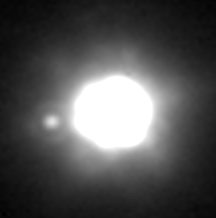Top Qs
Timeline
Chat
Perspective
762 Pulcova
Main-belt asteroid From Wikipedia, the free encyclopedia
Remove ads
762 Pulcova is a main-belt asteroid. It was discovered by Grigoriy N. Neujmin in 1913,[2] and is named after Pulkovo Observatory, near Saint Petersburg. Pulcova is 137 km in diameter,[2] and is a C-type asteroid, which means that it is dark in colouring with a carbonate composition.
Photometric observations of this asteroid from Leura, Australia during 2006 gave a light curve with a period of 5.8403 ± 0.0005 hours and a brightness variation of 0.20 ± 0.02 in magnitude. This result is in agreement with previous studies.[6]
Remove ads
Satellite


On February 22, 2000,[1] astronomers at the Canada-France-Hawaii Telescope on Mauna Kea, Hawaii, discovered a 15-km moon (roughly a tenth the size of the primary)[7] orbiting Pulcova at a distance of 800 km.[8] Its orbital period is 4 days.[9] The satellite is about 4 magnitudes fainter than the primary.[8] It was one of the first asteroid moons to be identified.
Remove ads
Density
In the year 2000, Merline estimated Pulcova to have a density of 1.8 g/cm3, which would make it more dense than the triple asteroid 45 Eugenia, and binary 90 Antiope.[8] But estimates by Marchis in 2008 suggest a density of only 0.90 g/cm3,[4] suggesting it may be a loosely packed rubble pile, not a monolithic object.
References
External links
Wikiwand - on
Seamless Wikipedia browsing. On steroids.
Remove ads

